Wake in Fright, or How to Contextualize like a Naturalist
Agustin Zarzosa
A scene toward the beginning of the Australian film Wake in Fright (Ted Kotcheff, 1971) illustrates how naturalism contextualizes. Based on the homonymous novel by Kenneth Cook, the film tells the story of John Grant (Gary Bond), a schoolteacher at Tiboonda—a fictional minuscule dust town in the outback.1 Grant considers himself a “bonded slave of the Education Department”: unless he returns to Tiboonda for another year, he will lose the one thousand dollar bond posted for him to procure the position.
Grant heads toward Sydney for the Christmas holiday. On his way to Sydney, he stays at Bundayabba for one night. A fictionalized version of Bunker Hill in New South Wales, Bundayabba—or the Yabba, as the locals call it—is a mining town populated largely by men. The only social impropriety in the Yabba consists in refusing a drink. The Yabba entraps Grant, luring him with the possibility of escaping Tiboonda by means of a rudimentary gambling game called two-up. Grant loses all of his money and enters a cycle of stupor and degradation. After failing to commit suicide, Grant recovers at the local hospital and returns to Tiboonda.
The scene in question takes place at an illegal two-up school, the third pub Grant visits during his stop at the Yabba. Two-up resembles pitch and toss: the ringmaster controls the game, the spinner tosses two coins on the kip (a small piece of wood) and players bet on either tails or heads. In the film, the tail side of the coins is marked with an X. After having won four hundred dollars, Grant runs to his room. He returns to the two-up school with the same haste he left it, hoping to win enough money to cover the one thousand dollar bond. Grant loses all of his winnings and decides to gamble away his paycheck.
Immediately after Grant places his bet, the other players irrupt in wild laughter. This quick succession of events suggests an unknown causal relation: Why is Grant’s wager laughable? Grant surveys the room, searching for a context that would explain the players’ laughter. Has his wager broken an unwritten rule? Are the players somehow aware that he is squandering all of his earnings? Or is he the victim of a mysterious communal scheme? While the laughter overruns the space, Grant scans the faces around him, both absorbing the laughter and searching for a plausible explanation. Eventually, an image dispels his fears. The players are not laughing at Grant but at the town fool, Doc Tyson (Donald Pleasence), who is placing a one-dollar bet.
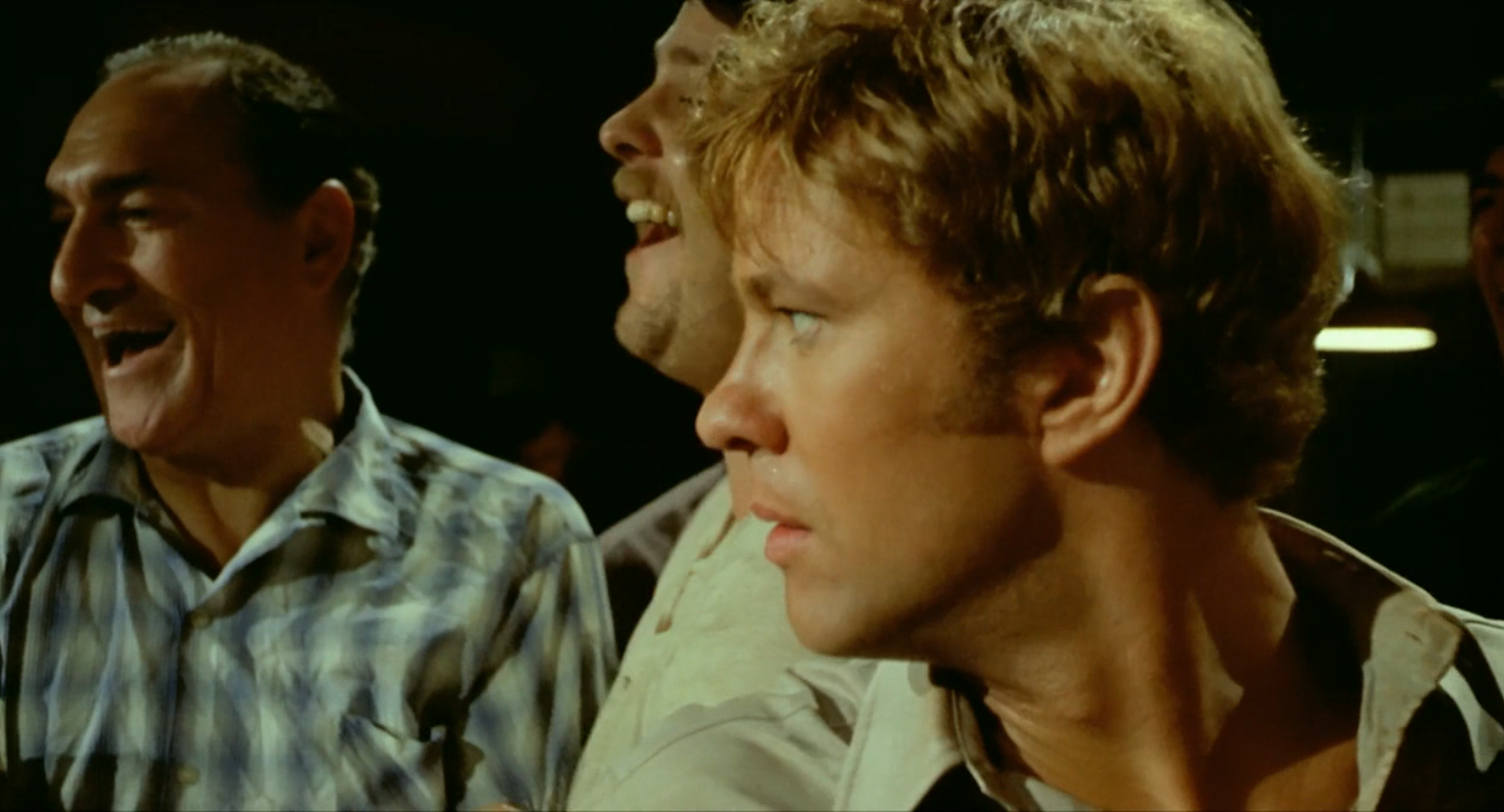
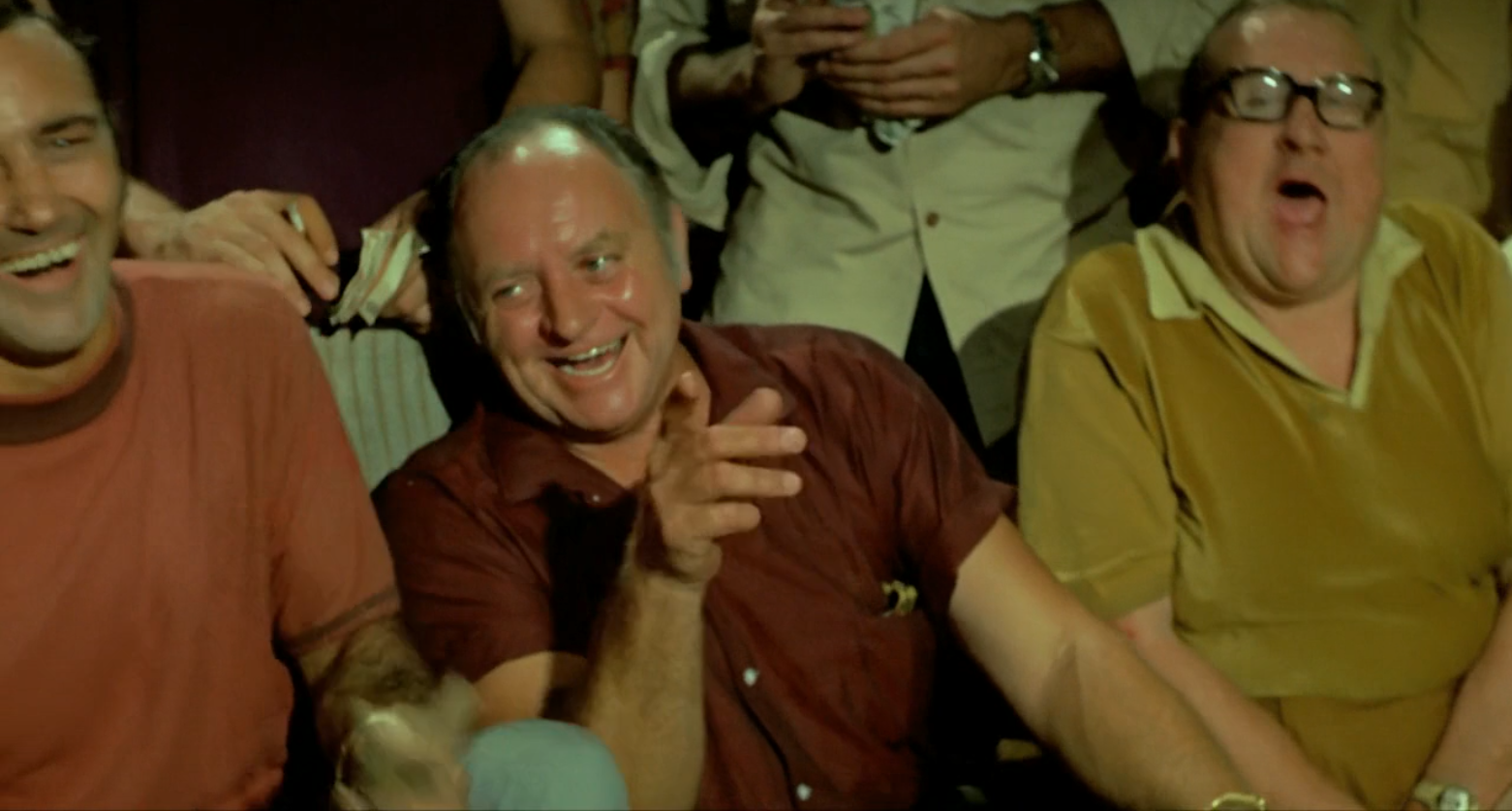
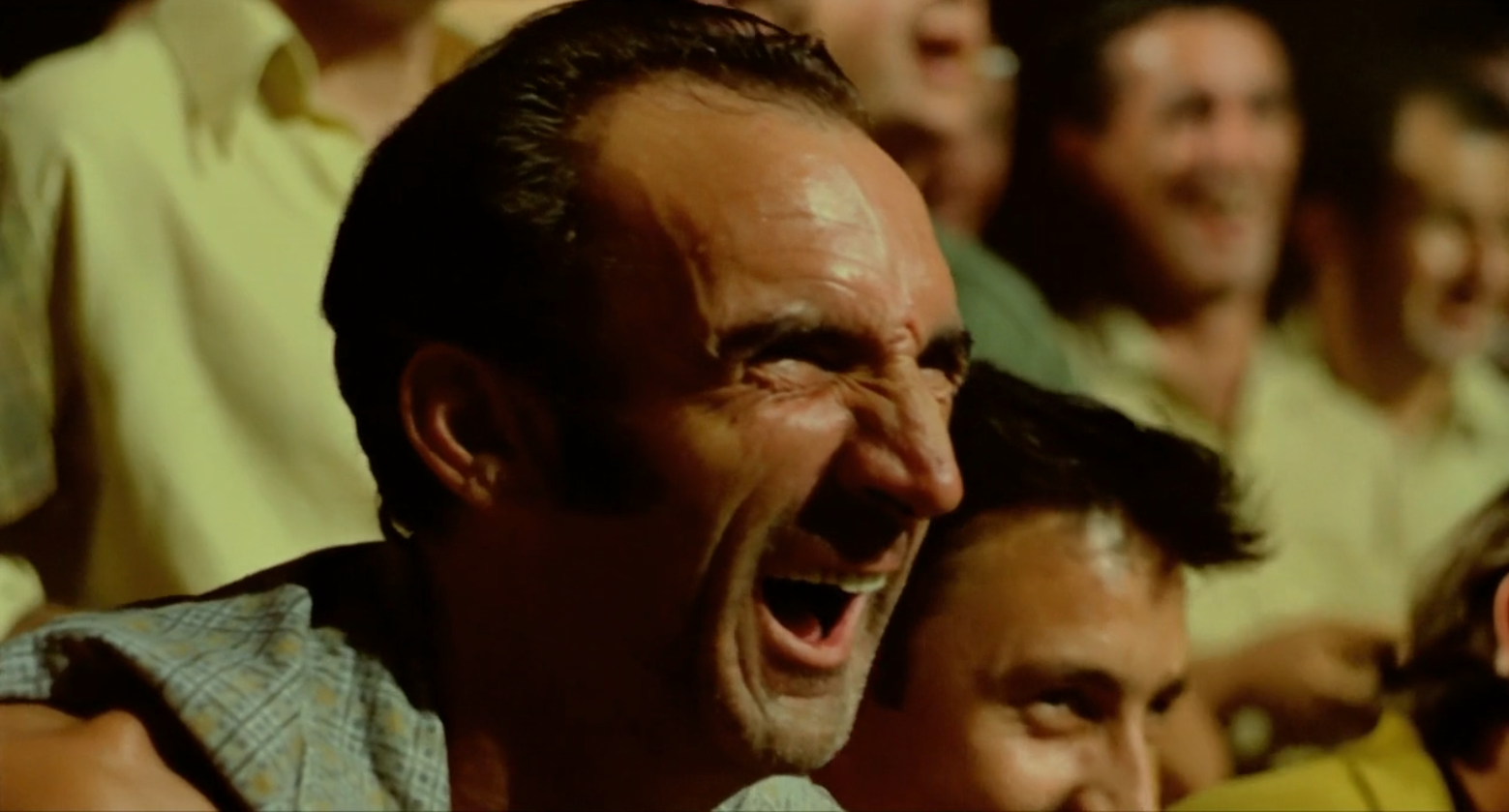
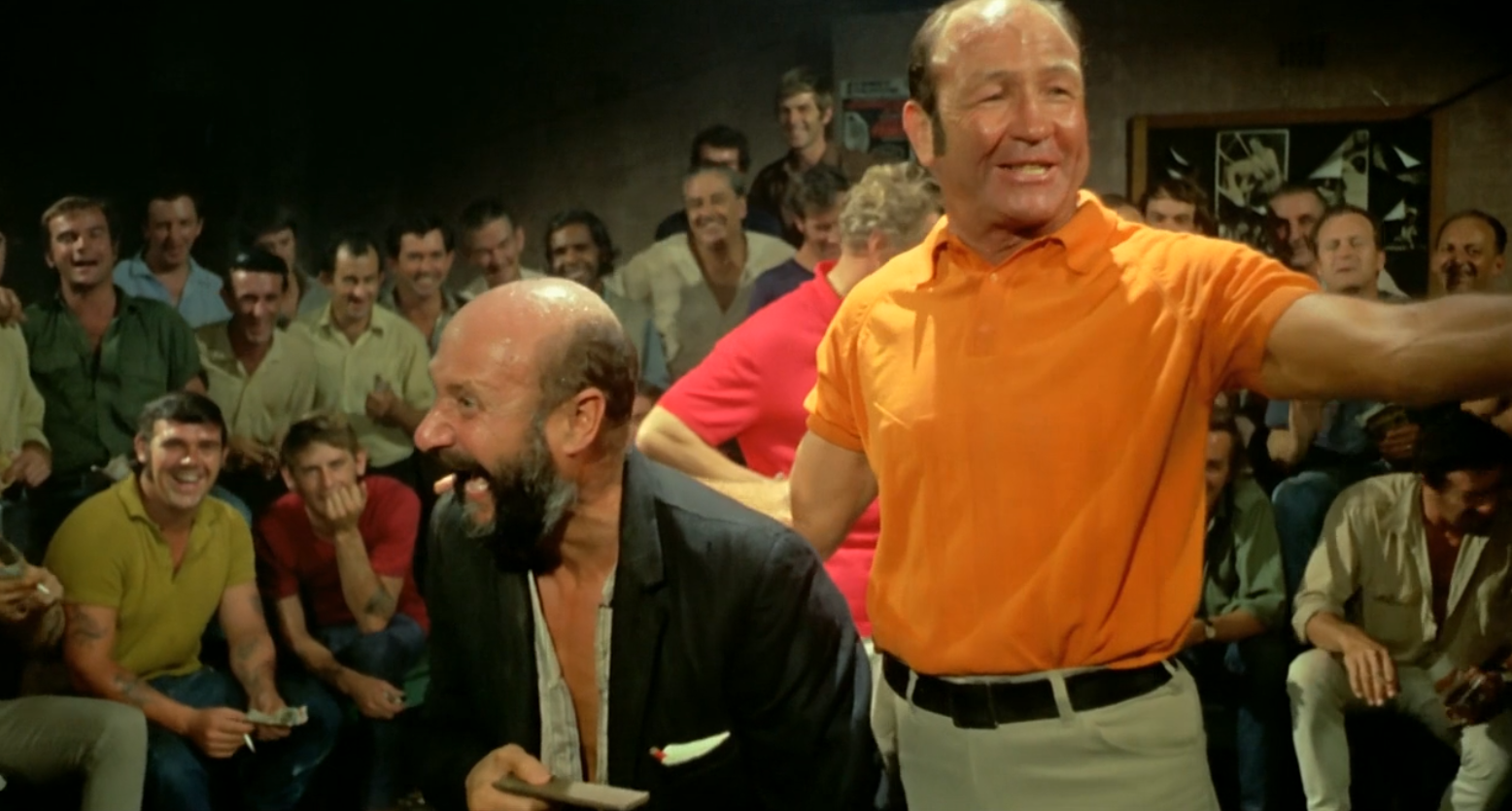
For the few seconds before the confusion is dispelled, Grant contextualizes the puzzling images around him in relation to his own apprehension. Afraid that he might be falling prey to a mystifying plot, Grant first understands this laughter as a result of an absent image that lies dormant in human bodies and surfaces through a crack within the social fabric. Émile Zola famously referred to this absent image as the human beast, an image that takes possession of bodies and overwhelms the social logic. Through this unrestrained laughter, the human beast appears to have taken control over the players’ bodies.
As a mimetic mode, naturalism constructs a particular mise-en-scène to dramatize the irruption of the human beast. Context in naturalism refers to the set of images choreographing both this irruption and the (oftentimes futile) mechanisms through which we attempt to keep the human beast in check. Taking as a point of departure Gilles Deleuze’s discussion of naturalism in Cinema I, this essay explains how Wake in Fright (and, more generally, naturalism) contextualizes, that is, how it organizes images to stage the emergence of the human beast. Naturalism contextualizes by superimposing two realms—which Zola refers to, respectively, as the natural and the social—and by creating nodes through which these two realms communicate.
The essay is composed of five sections. The first one addresses the issue of context and the moving image; the second one explains how naturalism departs from realism in terms of context; the third one discusses how, rather than distinguishing between event and circumstances, naturalism splits the image between the natural and the social. Dedicated to explaining how these two realms communicate, the last two sections analyze objects in Wake in Fright. The fourth section focuses on three objects: sunglasses, money and beer. The fifth section analyzes Grant’s relation to a more ethereal object—light—discussing how context becomes actualized in naturalism.
I. Context and the Moving Image
Before discussing the particularities of context in naturalism, I consider, more generally, the issue of context among moving images. This section makes two interconnected arguments regarding context. First, I claim that context aims at rendering a puzzling image intelligible. Accordingly, although context often involves contiguous images and causal explanations among them, the act of contextualization may also evoke distant images and non-causal relations. Second, I assert that the set of images we call context hinges on an affection, primarily an affection of puzzlement. The betting scene from Wake in Fright will serve to illustrate these two propositions.
The term context might elicit a mental picture resembling what we could more properly call surrounds, that is, the set of images encircling, preceding, and following an image. However, context is not primarily a spatial or temporal category; context is concerned with understanding an opaque or puzzling image. For this reason, even if we might make use of an image’s surroundings to contextualize it, we must establish relations among these images beyond mere contiguity. As Haydn White argues, context depends on a prior formal gesture to organize events. White claims that any act of contextualization requires a formal model on the basis of which “first, to distinguish contexts from the entities inhabiting them; second, to generate hypotheses about the nature of the relations between the entities and the contexts thus distinguished; and third, to discriminate between radical, primary, and determining transformations of these relationships and what are only secondary, superficial or local changes in them.” 2 Context does not restore images to their origin. More properly, context organizes images, striving to render them intelligible.
The betting scene from Wake in Fright illustrates how surrounds and context might become easily confused. Grant is finally able to understand the generalized laughter by discovering a contiguous image: Doc tossing the coins. However, what explains the laughter is not the image by itself (on account of its contiguity to others) but rather an inference about Doc’s role as the town fool.
The sense of an image might not lie in the images surrounding it; sometimes, to contextualize, we must remove an image from its surroundings and evoke distant images to elucidate its sense. To make this point, one need only consider the issue of allusion, that is, images that refer with varying degrees of explicitness to other images. In these cases, the context of an image does not fully lie within contiguous images but rather among distant images. If context often evokes contiguous images, it is only because images act powerfully on neighboring images.
Intelligibility may be confused not only with contiguity but also with causality. Rendering an image intelligible involves, quite simply, considering this image in light of another image (or a set of images). Although context might well evoke causal relations to render an image intelligible, context may also evoke non-causal relations—for instance, analogies, oppositions, or correspondences—to render an image intelligible.
In the case of the betting scene in Wake in Fright, Grant contextualizes a puzzling succession of events—the bet and the players’ laughter—by fearing that the hidden image of the human beast has irrupted. Grant’s expression results not only from the laughter but also from this naturalist fear. A celebrated passage by Béla Balázs on the close-up and physiognomy makes a similar point about context, causality, and expression (or affection). Balázs writes, “The abyss into which a figure peers no doubt explains his expression of terror, it does not create it. The expression exists even without the explanation. It is not turned into an expression by the addition of an imagined situation.”3 In a similar manner, Grant’s affection is explained by the laughter, which is itself explained by the image of Doc making a fool of himself. However, neither the laughter nor the image of Doc creates Grant’s affection or the relations he establishes among images.
In fact, it is context that is sustained by an affection. Before making this argument, it is necessary to elucidate the sense of affection. In Matter and Memory, Bergson proposes a world composed purely of images interrupted by what he calls centers of indetermination, intervals, or living images. Affection stands between perception and action: whereas perception refers to the same world of images in relation to a center of indetermination and action designates the center of indetermination’s delayed response to images, affection denotes the center of indetermination’s capacity to absorb images.
As is well known, Deleuze takes this framework as a starting point for his classification of cinematic images. Mark B. N. Hansen has pointed out that Deleuze betrays his Bergsonian inspiration by turning affection into a kind of image. Even if Bergson describes a world composed of images in Matter and Memory, he never refers to affection as a kind of image. Hansen explains how Deleuze homologizes a cut between shots with the Bergsonian center of indetermination. To establish this homology, Hansen argues, Deleuze must bracket Bergson’s “embodied concept of affection,” thereby disembodying cinema.4 Hansen writes, “Deleuze effectively imposes a purely formal understanding of cinematic framing and thus suspends the crucial function accorded the living body on Bergson’s account.”5
Although Hansen’s argument is impeccable in regard to Deleuze’s transformation of affection into a type of image, one should keep in mind that what Deleuze calls an affection-image is not affection proper but a cinematic sign. In other words, Deleuze’s argument is not that affection is a kind of image but that cinema makes of affection a sign. The affection-image is, in the simplest terms, the sign of subjectivity.
Significantly, Deleuze identifies the affection-image with the close-up rather than with the point-of-view shot (a more conventional sign of subjectivity). Furthermore, he defines the close-up not in terms of scale but in terms of the function of abstracting a figure from its surroundings.6 By separating itself from its spatio-temporal coordinates, affection opens a parallel space, imbuing its surroundings with unanticipated connections.
At first sight, context appears as the opposite of affection: whereas affection would refer images to itself, context would promise to obviate affection altogether and return images to the surroundings from which affection abstracts them. As I have argued, the act of contextualization does not seek to return images to their surroundings but rather to illuminate these images. Moreover, context is composed not only of the set of images we concoct to illuminate a bewildering image but also of the affection that both contrives and pervades these images. Put differently, context only becomes pertinent when one is out of it, in need to account for puzzling images.
To situate this argument in terms of the gambling scene from Wake in Fright, we should understand Grant’s perplexed response to the generalized laughter as an essential component of the context he evokes. The images depicting the players are not a pure perception—that is, Grant’s point of view—but rather a perception alloyed with an affection, itself combining fear of derision and uncertainty about why he is being laughed at. Rather than subjective images, these are naturalist affections, a composite of the images surrounding a body and images of the body’s apprehension of what might become of it. In these moments of confusion, Grant observes the human beast peeking through this wild laughter.
With these two propositions in mind, the following two sections discuss the particular way in which naturalism contextualizes. The next section will be revisiting the distinction between naturalism and realism. Naturalism distrusts the explanatory power of the kinds of context that realism evokes to make sense of human action.
II. Narrate or Dis-cribe?
The scientific theories that dominated the second half of the nineteenth-century offer an important context to account for the specificity of naturalist literature. Among the most relevant of these scientific innovations are Charles Darwin’s theories of evolution and natural selection, Ernst Haeckel’s recapitulation theory, August Weissmann’s germ plasm theory, Prosper Lucas’ treatise on heredity, and Cesare Lombroso’s theory of criminal atavism. These scientific innovations propelled what could be considered an internal split of realist literature between realism and naturalism. What distinguishes naturalism from realism is not only the biological model of human action that underlies these theories but also a rhetoric that would render these theories legible within the fiction. In other words, in addition to offering a context for understanding naturalism, these theories imposed a novel manner of contextualizing.
Naturalism’s strong emphasis on description is closely connected to this distinct way of contextualizing. Zola finds the term description unsuitable to the extent that naturalism does not describe “for the sake of describing, from a caprice and a pleasure of rhetoricians.”7 To explain the particularities of description in naturalism, Zola establishes an analogy between the naturalist author and a zoologist. In studying an insect, the zoologist must describe the plant and environment in which the insect lives. This description, Zola writes, “enters into the very analysis of the insect.”8 Zola considers that, in a similar manner, “man cannot be separated from his surroundings, that he is completed by his clothes, his house, his city, and his country.”9 Accordingly, Zola defines description as “an account of the environment which determines and completes man.”10
In “Narrate or Describe?” Georg Lukács argues that, rather than anchoring characters within their environment, naturalism’s excessive description achieves the opposite effect, divorcing characters from their social setting. Whereas realism affixes human action in the social world by subordinating description to narration, naturalism’s “obsession with monographic detail” misses the ideal proportion between action and setting. Lukács distills this argument into the following formula, “Narration establishes proportions, description merely levels.”11 As a result, naturalist texts are characteristically composed of “a series of static pictures, of still lives connected only through the relations of objects arrayed one beside the other.”12 Having lost its epic quality, action in naturalist works is reduced to “a thread on which the still lives are disposed in a superficial, ineffective fortuitous sequence of isolated, static pictures.”13 In regard to the problem of context, Lukács’s argument suggests that the material world in naturalism tends toward becoming text rather than remaining properly context.
Winfried Fluck distinguishes realism and naturalism more explicitly in terms of context. Situating his argument in relation to American literature, Fluck contends that American naturalism is marked by a “programmatic decontextualization” and should not be understood “merely as a radicalization of the realist project.”14 His conception of realism ties personal to social experience. By rejecting both religious and metaphysical revelation, realism proposes experience as the uttermost criteria of knowledge. In realism, characters make sense of “singular experiences as part of a larger context,” that is, as social experience.15 Conversely, the experiences undergone by naturalist characters reflect the “underlying constituents of reality that are obscured by the idea of civilization.”16 Accordingly, realism and naturalism offer competing conceptions of reality: whereas realism considers reality “a sphere that can be rationally studied,” naturalism “redefines it as a sphere that escapes civilizatory (and therefore also rational) control.”17
David Baguley’s seminal study Naturalist Fiction allows us to approach the issue of naturalist context from a different perspective. Baguley argues for a conception of literary naturalism as a recognizable genre with a set of thematic features and a common vision aiming at the breakdown of the social by means of biological forces; therefore, naturalism focuses on “the very process of disruption, the disintegrating order of mimesis itself.”18 Baguley expresses this process of mimetic disintegration in Schopenhauerian terms, locating at the heart of naturalism a struggle between representation and the will. He writes, “In naturalist works, however willing the spirit, the flesh is far too strong, for there is a kind of primitive ‘nature’, an irresistible, universal, depersonalised, instinctive (Schopenhauerian) Will that rises to the surface, saps the individual’s sense of human values and brings about the decline.”19
Description, Baguley explains, makes possible this mimetic disruption. Unfolding analogously to the human drama throughout the fiction, naturalist description follows “the dissolution of the forms of the environment which decompose before the eyes of the reader or of the intradiegetic observer.”20 Accordingly, Baguley refers to description in naturalism as dis-cription, that is, as a series of “disjunctions, dissolutions and dissociations” through which the disintegrating décor encroaches upon the characters.21
Naturalism erodes not the material world as a whole but, more precisely, its social contours, delivering characters to the natural environment. Without the mediation of social legibility, human appetites appear in their nakedness as a never-ending cycle of cravings and longings. For this reason, what Fluck calls naturalism’s “programmatic decontextualization” constitutes, more properly, an alternative to the sense that realism imposes to context. At stake in naturalism’s break with realism are the nature and limits of context. From the perspective of realism, naturalism decontextualizes by deemphasizing the social dimension of human action and by adopting a model of biological determinism. From the vantage of naturalism, realism imposes a restrictive sense to context, failing to take into consideration that social environments remain artificial configurations of an underlying natural relation to the world. The following section discusses how naturalism dissolves the social into the natural.
III. The Breakdown of Context
Paradoxically, naturalism contextualizes by breaking down context as such. In other words, naturalism dismantles the distinction between event and circumstances. Rather than offering a circumstantial explanation of events, naturalism constructs a two-layered world, leaping from one to the other to stage the appearance of the human beast.
Extrapolating Claude Bernard’s thesis that the behavior of higher organisms is determined by a combination of external and internal environments, Zola proposes that social behavior is determined by a combination of surroundings (external environment) and heredity (internal environment). However, Zola does not explain how heredity and surroundings act upon one another. He simply writes that they are “of equal importance.”22 Hence Zola refers to the Rougon-Macquart series, which comprises twenty novels and follows a family cursed with a ravenous appetite during the Second Empire, as both a natural and social history.23
In naturalism, social history is powerless to account for human behavior by itself. The name of the supplement necessary to explain human behavior is precisely naturalism. More than anywhere else, this supplementarity is apparent in the design of Zola’s Rougon-Macquart series. By focusing on the legitimate and illegitimate descendants of Adelaïde Fouque, a slightly disabled woman, Zola examines how an original hereditary fêlure (flaw/crack) acquires different forms across generations and across different settings characteristic of the Second Empire. The series does not suggest a causal relation between heredity and social reality. More precisely, the series points to the ways in which social reality gives historical shape to the appetites that spring from the original fêlure.
This distinction between natural and social is, to a certain extent, a way of figuring the process by which all social phenomena turn against themselves, thwarting their own apparent logic. It is in this sense that we should understand Deleuze’s argument in The Logic of Sense that heredity does not refer to a particular content moving from one body to another through the fêlure but rather to the fêlure itself. Deleuze writes, “Heredity is not that which passes through the crack, it is the crack itself—the imperceptible rift or the hole.” To emphasize the indivisibility of the natural and the social, Deleuze refers to these realms, respectively, as the originary world and the derived milieu. He explains that these two realms “will not let themselves be separated and do not take on distinct form.”25
The naturalist image is characteristically split between its social and its material dimension. Wake in Fright superimposes these two realms from the very beginning. The film opens with a 360-degree panoramic crane shot of the dusty, scantly vegetated plains that surround Tiboonda. The plains are traversed by train tracks, along which runs a series of utility poles. Facing each other between the tracks, two puny buildings are visible: a school and a tavern that doubles up as a lodge for Grant. In a contrasting scene at the Yabba, the camera follows Grant while he enters a crowded bar open after its alleged closing time. When Grant enters, a man asks Grant that he close the door behind him because the bar is closed. Placed on a crane, the camera is raised while Grant makes his way through a room full of sweaty men, many of whom are shirtless. The bar is decorated with Christmas adornments (one of which shows a drunken Santa Claus) and the only women at the bar appear to be servers. Both spaces clearly miss the ideal balance between natural environment and human life; human action has failed to imbue these spaces with a sense of proportion. Rather than offering a contrast between nature and civilization, Wake in Fright populates the world with incongruous beings in between the two.
This incongruity is already marked by the term yabba, which holds a myriad of meanings. Of course, yabba is shorthand for Fred Flintstone’s battle cry Yabba Dabba Doo, an expression of excitement that usually celebrated the end of the workday. Yaba is the Thai name for Nazi speed, a methamphetamine laced with caffeine that keeps users awake for days and leads to hallucinations. In the Australian context, Yabba is the nickname of Stephen Gascoigne, a popular sports fan and heckler during the early part of the 20th century. More importantly, yabba is also an Australian Aboriginal English word that means “talk.” In the novel, Grant makes this connection explicitly. When a cab driver speaks obsessively about the Yabba, Grant wonders, “wasn’t Yabba Aboriginal for talk?”26 At the Yabba, the source and meaning of sounds are difficult to determine. As Monique Rooney writes in her analysis of the novel, “Such aural impressions, forming both calls and responses, emanating from human and non-human alike, crowd the novel.” 27 In another passage of the novel, Grant closes his eyes and the voices of the Yabba-men become “a constant unbroken drone.”28
The film depicts this aural confusion at the exact moment that Grant arrives at the Yabba. Grant has put on his sunglasses to block the men singing in the back of the train compartment. He begins to fantasize about his girlfriend at a beach. Suddenly, a loud voice seems to join the singing men, muffling the sound of the waves in Grant’s fantasy. Grant seems confused about the source of the voice that disturbs his fantasy. He turns toward the indigenous man sitting next to him, but the indigenous man appears to be merely mumbling rather than signing out loud.
This aural dislocation is part of the film’s naturalist rhetoric that, in Baguley’s terms, dis-cripts material objects from their social configuration. The Yabba itself is a fabled double of Broken Hill, an actual mining city that inspired Cook to write Wake in Fright. Both real and fantastic, the Yabba is a topsy-turvy world with its idiosyncratic rules and rituals. For instance, the players at another bar are commemorating Anzac Day—the equivalent of Memorial Day in Australia and New Zealand—during the Christmas holiday. Anzac Day, which pays tribute to Australian and New Zealand soldiers who fought during World War I, is usually celebrated on April 25th. The explanation for this displacement lies in the connection between two-up and Gallipoli.29 Two-up was popular among Australian soldiers during the Gallipoli campaign in World War I. At the time the film takes place, two-up was illegal in Australia at any other times other than Anzac Day. The ritual turns the exception into the rule, declaring every day to be Anzac Day at the Yabba and, therefore, making two-up permissible.
Because of this dislocation, objects in naturalism appear to be pulled in two opposite directions: toward myth and toward a pure materiality. Objects in Zola’s novels often acquire mythical qualities: the still in L’Assommoir, the train in The Human Beast, the mine in Germinal, Nana’s mansion, the food market in The Belly of Paris, or the department store in The Ladies’ Delight. Brian Nelson refers to this fusion of myth and reality as surnaturalism, explaining that Zola “infuses the material world with anthropomorphic life, magnifying reality and giving it a hyperbolic, hallucinatory quality.”30 David Trotter has isolated the contrary impulse in naturalism, which he calls the phobic picturesque. In naturalism, Trotter explains, description fails to derive meaning and value out of objects, rendering them pure matter. Contextualizing naturalism in relation to the rise of the clinical interest in phobia, Trotter argues that “the fierce attention directed at a single object (…) neither illuminates it, nor derives illumination from it.”31 Naturalism derives instead disgust and nausea from this exhaustive attention.
Naturalism unhinges objects from their social signification, placing characters in an unmediated contact with the natural world. It is this unmediated contact that generates both disgust and the magnification of reality that Nelson calls surnaturalism. Disgust is the appropriate response to the irruption of the appetites through the material world; surnaturalism is nothing other than the tendency to mythologize this irruption. The next section analyzes how Wake in Fright articulates this irruption of the appetites.
IV. Of Sunglasses, Money, and Beer
Objects play an essential role in naturalism because they alternatively incarnate the appetites that emerge from the material world and fend off their irruption. Wake in Fright dramatizes primarily three objects: Grant’s sunglasses, money, and beer. The sunglasses shield Grant—albeit insufficiently—from the sunlight, the incorporeal yet brutal manifestation of the outback. Money and beer are involved in contrasting systems of exchange.
Despite the outback’s brutal sunlight, Grant is the only character who wears sunglasses throughout the film. It might appear at first that the sunglasses signal his cosmopolitanism, marking his cultural difference from the inhabitants of the outback. More precisely, the sunglasses set up an actual screen between Grant and the environment: Grant first puts on his sunglasses while he leaves the school building, protecting himself from the Tiboonda sun. The sunglasses also protect Grant from the social environment, allowing him to enter a fantasy space. In the scene on the train I mentioned above, Grant puts on his sunglasses immediately before he arrives at the Yabba. He lays his head on the train chair, opens his wallet to view a photograph of his girlfriend, and begins fantasizing about her and the beach. For a brief moment, the sunglasses allow him to counter the images of the outback with images of his own.
The sunglasses also play an important role during a night scene. Grant returns to his hotel room, rejoicing about having won four hundred dollars at two-up. The math and English textbooks remind him that, despite his winnings, he must still return to Tiboonda. He grabs the money and leaves the room, but the camera lingers for a few seconds on the sunglasses he has left on the desk. This lingering shot conveys the point that no screen protects him from the Yabba. Once Grant has lost all of his money, the sunglasses lose their power to protect him from the environment. The morning after, Grant exits the hotel to be greeted by the brutal sunlight. He looks up at the sky and sees a plane flying away, presumably the plane that would take him to Sydney. Grant puts on his sunglasses. This time, he seems to enter a nightmare rather than a fantasy space. A Santa Claus suspended from a storefront appears to be laughing at him.
The sunglasses reappear when Grant has reached his lowest point: in the span of three days at the Yabba, he has gambled all his money away, lived in a drunken stupor, failed to make love to a woman, gone on a senseless kangaroo killing rampage, and had sex with the town fool. As he leaves Doc’s shack, Grant tries to put on his sunglasses only to realize that one glass is missing and another broken. He must escape the Yabba without any kind of protection.
The second object I discuss—money—is arguably the foremost naturalist object. Naturalist fiction abounds with squandered fortunes, wild speculation schemes, reckless gambling, destitution and vagrancy. In Wake in Fright, gambling offers Grant the possibility of leaving Tiboonda behind. The pennies in two-up lend their body to chance. In the classical and realist traditions, chance is often viewed as problematic to the extent that it suggests contrivance. In the naturalist tradition, on the other hand, chance implies the presence of an outside that undermines the actions of characters and the rational arrangement of events. As a hero in a classical narrative, Grant has an immediate purpose: to spend the winter vacation in Sydney. However, he must return to Tiboonda for another school year. By gambling his earnings, Grant leaves behind the decision between honoring his commitment and pursuing a different career in Sydney or London. Rather than choosing between these two options, Grant chooses chance instead. The two coins decide whether he will able to pay off his bond or he will be left penniless; the coins themselves mark a turning point from a narrative of objectives to a narrative of survival and degradation.
The coins appear one last time in Grant’s thwarted fantasy toward the end of the film. In wishing to arrive in Sydney by hitchhiking, Grant unknowingly returns to the Yabba. While he makes his way to Doc’s shack, images assault Grant without any possibility of controlling them. Devoid of his sunglasses, Grant can’t respond to his situation; the context he weaves combines images of Grant’s spiral toward degradation with fantasized images of Doc’s own depravity. The sequence ends when two coins—each marked with an X—return, through reverse motion, to Doc’s own eyes, as if Doc were the man behind the curtain and as if the coins had acted all along as Doc’s surrogates.
A one-dollar bill also plays an important role in the film. Perhaps Grant is able to escape his naturalist cycle of degradation because he never spends the one-dollar bill the hotel clerk returns to him after he checks out from the hotel. Because money mediates exchange in the civilized world, the possession of this banknote ties Grant, however slightly, to the world he has momentarily left behind.
Unlike what happens in other classical naturalist tales such as L’Assommoir or Sister Carrie, losing all source of income does not lead to misery at the Yabba. As Doc explains to Grant, because of the natives’ hospitality, one can survive in the Yabba without any money. Destitution only leads to a kind of gift-exchange economy in which the currency is beer, the third object I discuss. The scene framing the two kangaroo killing rampages (one during daytime and another during nighttime) suggests a generalized complicity among objects. Along with Dick (Jack Thompson) and Joe (Peter Whittle)—two miners—Grant and Doc take respite from killing kangaroos by heading to an isolated bar. As the car approaches the bar, the camera frames in the foreground a massive beer bottle standing above the bar. The beer, ocher like the dusty desert in the background, reminds the viewer not only of the suspended Santa Claus but also of the pennies, since the beer bottle is marked with four Xs.32
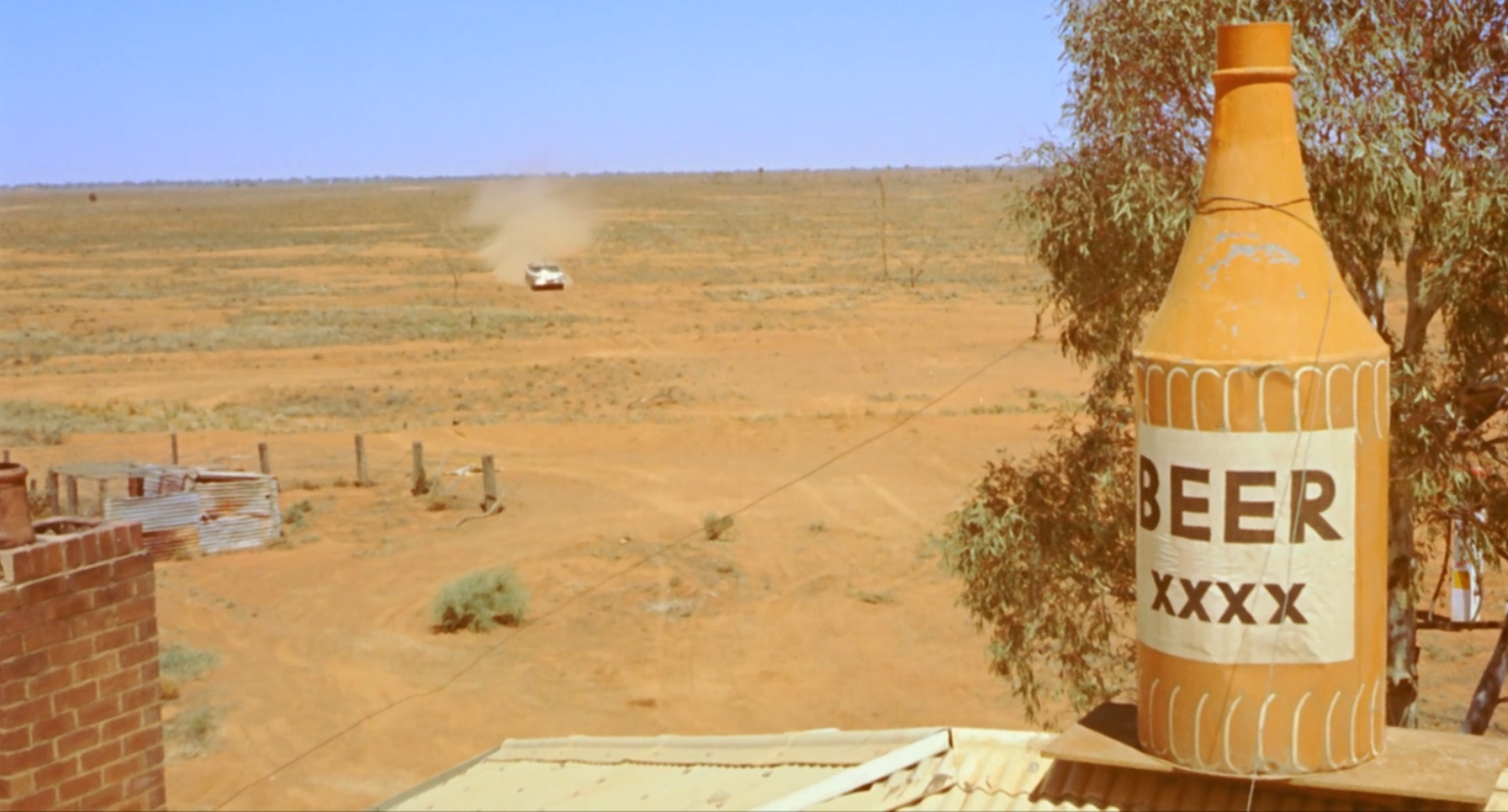
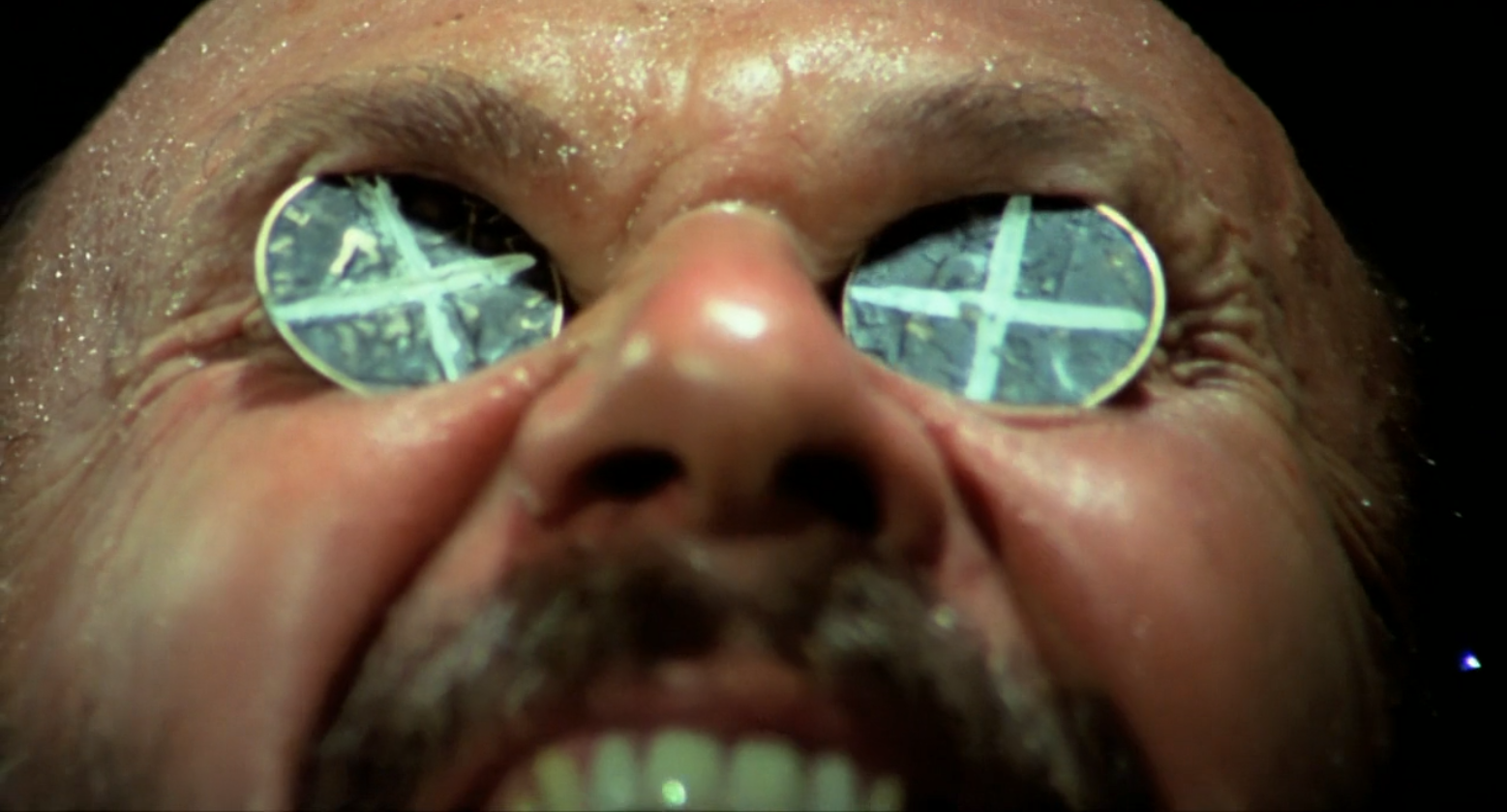
Virtually all of the male characters Grant meets at the Yabba offer him a beer. They do not seem to ask for anything in exchange: what is implicitly expected in return is that Grant weaken his resistance to the Yabba and that he become a Yabba-man. The exchange of beer frames Grant’s trip. As Grant boards the train from Tiboonda to the Yabba, a drinking party offers him a beer. Wearing his sunglasses, Grant refuses the offer and passes by the party. During his return trip to Tiboonda, Grant—no longer wearing any sunglasses—accepts a beer without any resistance. His docile acceptance suggests that what we have witnessed might be the first of several naturalist cycles to come and that he has become a willing participant in the exchange of desire at the Yabba.
Grant’s sexual fantasy on the train to the Yabba also suggests that the nightmarish naturalist cycle has satisfied his own desire. Before the singing of his fellow travelers interrupts Grant’s fantasy, a beer comes between Grant and his girlfriend within the scenario he concocts. The external interruption only serves to mask the self-imposed obstruction. Beer indefinitely postpones the satisfaction of his heterosexual desire, situating Grant within a system of exchange and desire among men.
V. Illuminating the Human Beast
This last section examines the role of light, a more insidious object than the ones I analyzed above. Light is the most tangible manifestation of the bodiless outside that the term Yabba attempts to describe. The Yabba acts through both natural and artificial light to break down Grant’s defenses.
By following Grant’s relation to light, we can observe how context—which is at first no more than an absent image—becomes actualized in Wake in Fright. I have been arguing that naturalism contextualizes by evoking the beast concealed within human bodies. When the human beast makes its appearance, affections become too stunned to evoke any context. Naturalism arrives at the point that context becomes not only unnecessary but also impossible.
Toward the beginning of the film, sunlight attacks Grant directly. His only means of defense, as I discussed above, consists in wearing a pair of sunglasses. Grant’s relation to light changes during his first night at the Yabba. Grant is caught unawares during nighttime. Artificial light acts as a stand-in for the harsh sunlight of the outback, blinding him in several occasions. When Grant enters the two-up school, a bouncer illuminates his face with a flashlight. Grant is blinded once again when he acts as the spinner in two-up and tosses the coins. Grant first tosses the coins with the light behind him. However, his toss lacks the necessary height for a legal throw. When he tosses the coins for a second time, Grant looks above and stares at the lamps above him. Blinded by the light for a few seconds, Grant does not realize that he has lost all of his winnings in a single throw. This complicity between natural and artificial light is emphasized the first morning Grant wakes up in Doc’s shack. In a figuration of the fêlure, rays of light—acting like a flashlight—pierce the ramshackle roof and wake Grant up.
During the kangaroo hunt, Grant places himself behind the light—albeit briefly—in what we could identify as the position of the predator who throws light on his prey. The hunters enter the heart of the Yabba, a realm in which life loses its recognizable forms. As the hunters scan the territory, a steering headlight placed above the car discovers images of dried up trees. When the headlight finds the kangaroos, the unwitting victims look directly at it, not blinded by the light but unable to see anything beyond it. This mise-en-scène serves as a context to understand the rest of the film. Retrospectively, the scenes in which Grant is blinded by light acquire the sense that he has been a victim of the Yabba, a victim as unsuspecting as the kangaroos. Moreover, the seduction/rape sequence is figured after the kangaroo hunt. After returning from the hunt, Doc shoots the source of light and turns on a hanging lamp, which he directs at Grant’s sight, as if Doc were the predator and Grant a kangaroo. To emphasize the analogy, Doc even simulates slitting Grant’s throat.
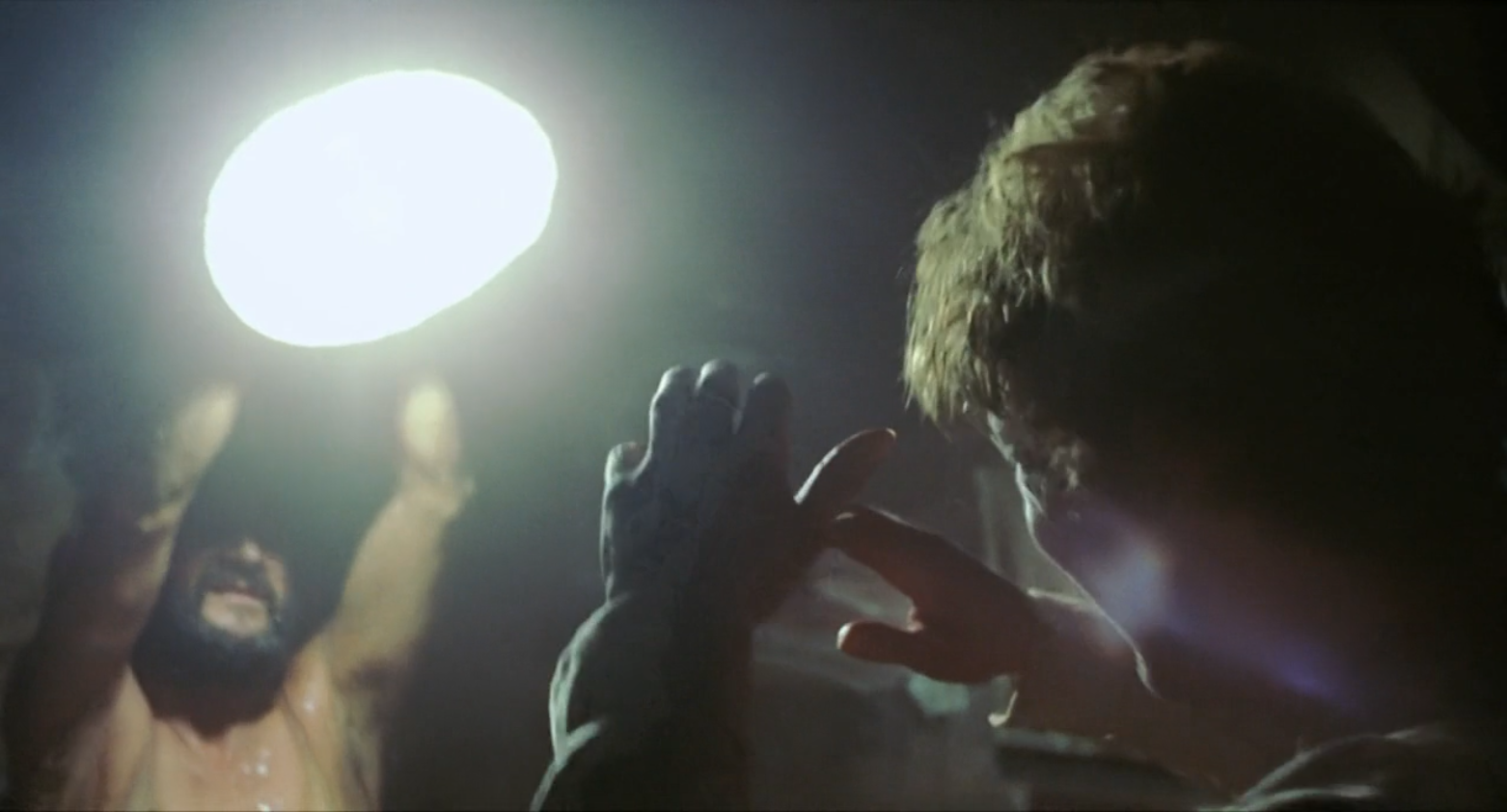
The cycle concludes when Grant steps into the light of his own accord. He fights with a wounded baby kangaroo while Dick and Joe stand behind the light. At this point, Grant is no longer out of it. The (naturalist) context implied in other scenes becomes actualized in a direct image of the appetites. The human beast appears in all its nakedness.
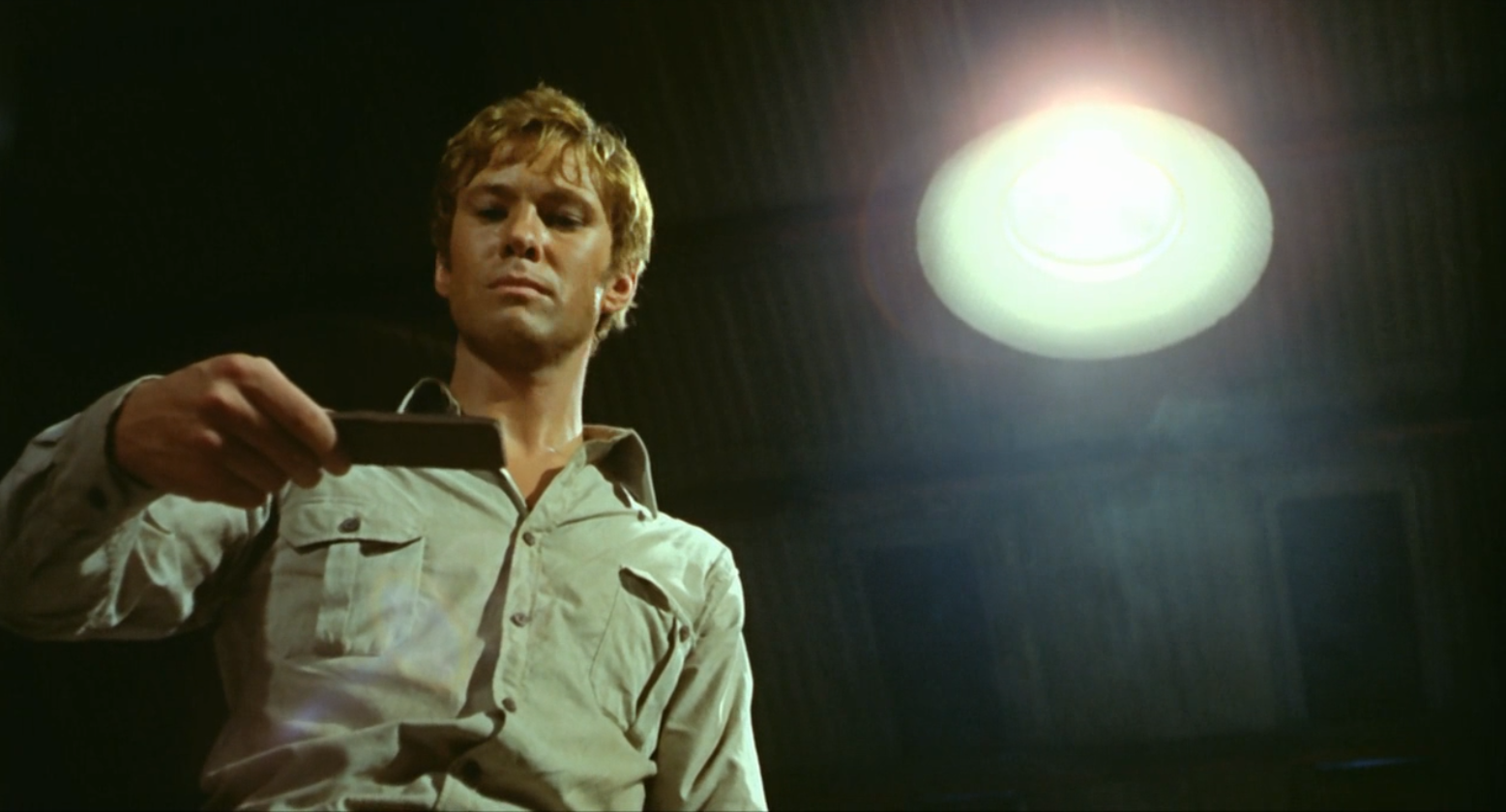
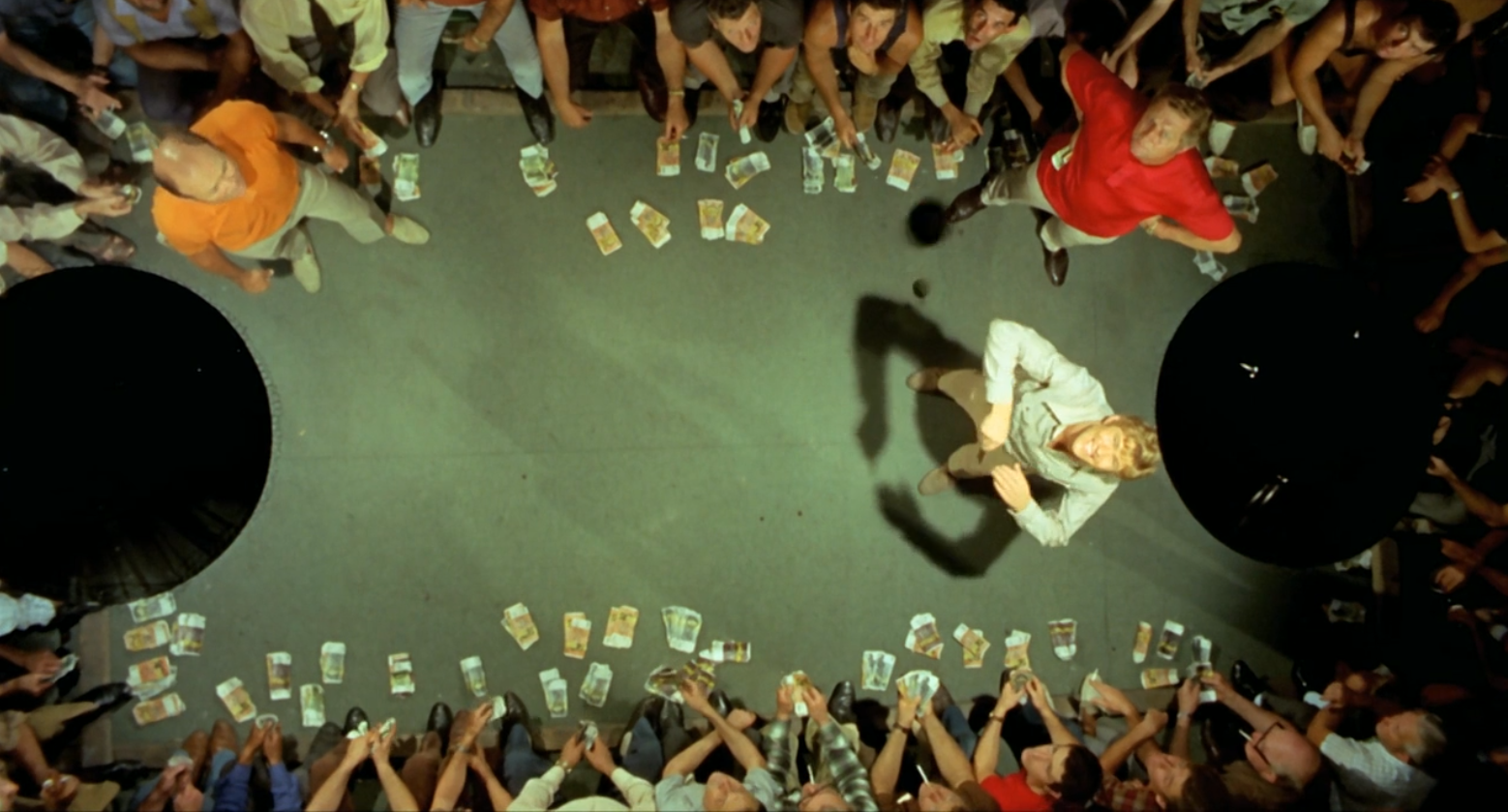
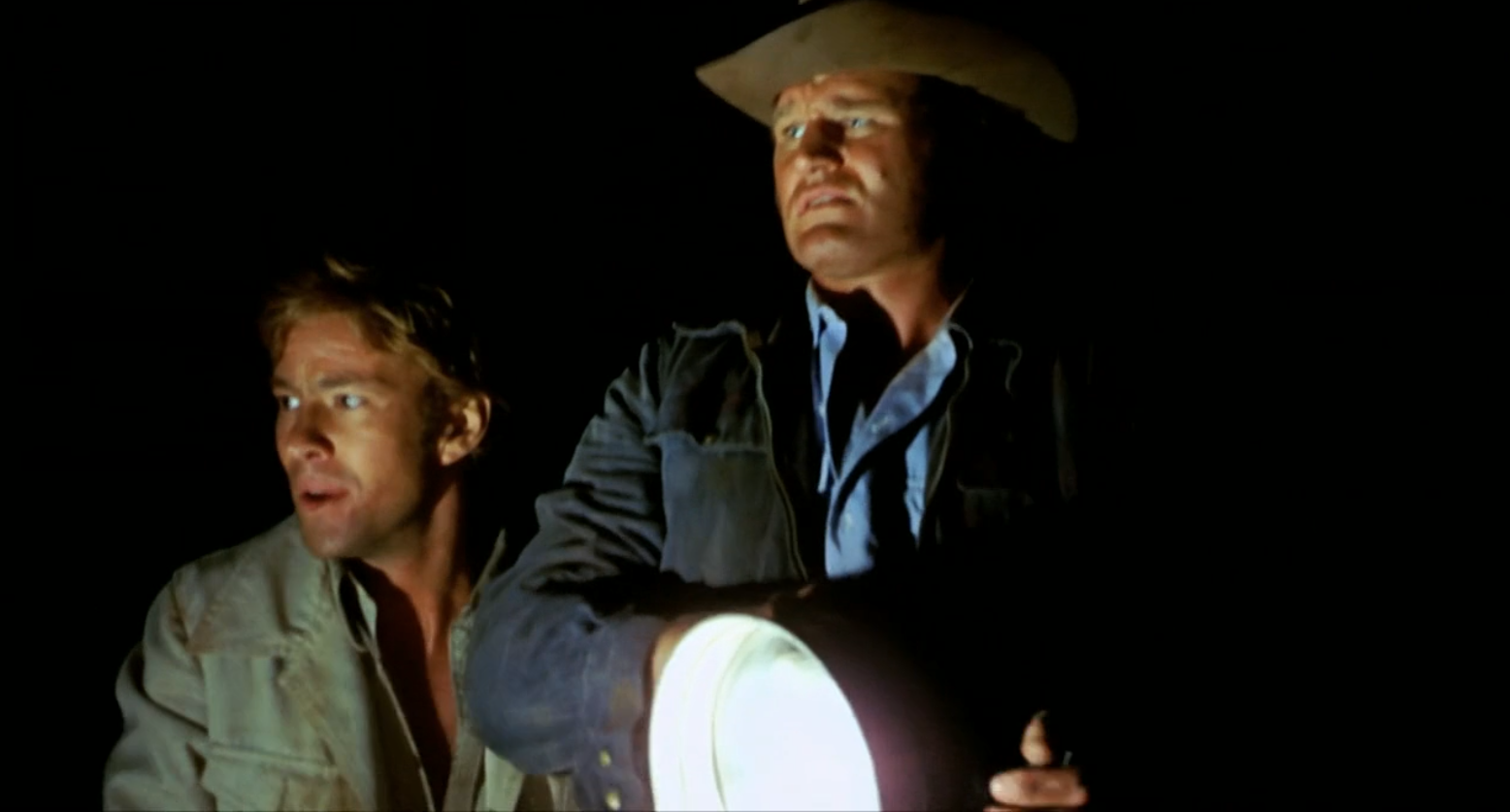

It is instructive to compare this scene with the one in which Grant gambles away all of his earnings. In the betting scene, Grant remains out of it, surveying images to reveal their sense. Eventually, Grant’s fear is assuaged by the image of Doc acquiescing to playing the role of the town’s fool. In the kangaroo hunt, Doc and Grant have traded places. Grant performs for the pleasure of the Yabba-men and Doc remains the silent observer of the scene of cruelty and willing self-degradation.
Rather than examining images to understand their sense, Grant becomes the image itself, the body in which the human beast reveals itself. At this point, the film completes the process of naturalization that, as Michel Serres explains, plunges “the observer in the tumultuous field of the observed.”33 Grant is not unlike Doctor Pascal, protagonist of the last among the twenty novels that compose the Rougon-Macquart cycle. Like a double of Zola, Pascal closely follows the lives of the descendants of Adelaïde Fouque. Pascal, who is himself a member of the family, registers in his genealogical tree how the original fêlure metamorphoses in each of the family members. Pascal believes that he has been spared from the fêlure until a love affair with his niece Clotilde uncovers the fêlure that had remained disguised as scientific zeal. Like Pascal, Grant searches for the human beast among the Yabba-men only to discover it within himself.
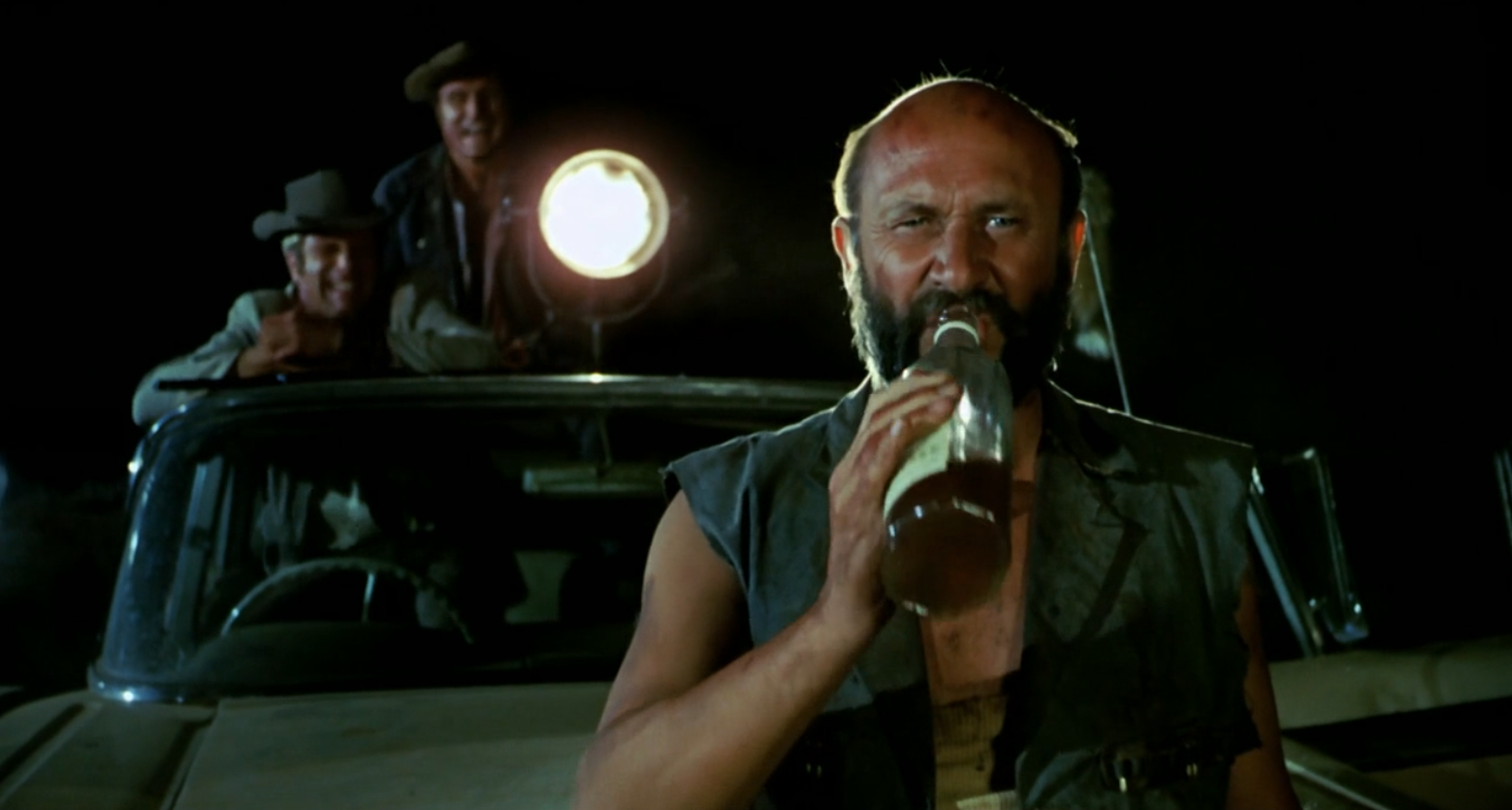
Despite his role as an observer at the end of the kangaroo scene, Doc is not out of it either. He shows no perplexity, offering only the resigned knowledge that the naturalist cycle must repeat itself. The kangaroo presents the only affection untainted by the depravity of the scene. However, this affection is unable to make sense of the violence assaulting it; in other words, this affection cannot afford a context.
Notes
Agustín Zarzosa is Associate Professor of Cinema Studies and Chair of Film and Media Studies at SUNY Purchase. His book, Refiguring Melodrama in Film and Television: Captive Affects, Elastic Sufferings, Vicarious Objects, has been published by Lexington Books. His essays on melodrama and film theory have appeared in New Review of Film and Television, World Picture, Cinema, Angelaki, and Discourse. He is currently developing a project on naturalism in classical Hollywood cinema.
The outback refers to the remote and sparsely inhabited areas of inland Australia.
Haydn White, “Formalist and Contextualist Strategies in Historical Explanation,” in Figural Realism: Studies in the Mimeses Effect (Baltimore: John Hopkins University Press, 1999), 51.
Béla Balázs, “The Spirit of Film,” in Béla Balázs: Early Film Theory, ed. Erica Carter, trans. Rodney Livingstone (New York: Berghahn, 2010), 100 (emphasis on original).
Mark B. N. Hansen, New Philosophy for New Media (Cambridge: MIT Press, 2004), 6.
Ibid., 7.
See Gilles Deleuze, Cinema 1, trans. Hugh Tomlinson and Barbara Habberjam (Minneapolis: University of Minnesota Press, 1986), 104.
Émile Zola, “The Novel,” in The Experimental Novel and Other Essays, trans. Belle Sherman (New York: Cassell, 1893), 232.
Ibid.
Ibid.
Ibid., 233.
Georg Lukács, “Narrate or Describe?,” in Writer and Critic, trans. Arthur Kahn (Lincoln, NE: iUniverse, 2005), 127.
Ibid., 144.
Ibid.
Winfried Fluck, “Beast/Superman/Consumer: American Literary Naturalism as an Experimental Literature,” in Romance with America?: Essays on Culture, Literature, and American Studies, ed. Johannes Voelz and Laura Beiger, Universitatsverlag Winter (Heidelberg: Johannes Voelz and Laura Bieger, 2009), 203–4.
Ibid., 199
Ibid., 204.
Ibid.
David Baguley, Naturalist Fiction: The Entropic Vision (Cambridge; New York: Cambridge University Press, 1990), 191.
Ibid., 212–3.
Ibid., 200.
Ibid., 203.
Émile Zola, “The Experimental Novel,” in The Experimental Novel and Other Essays, trans. Belle Sherman (New York: Cassell, 1893), 20.
Situated between the Second and Third Republic, the Second French Empire spanned from 1852 to 1870. The Fortune of the Rougons, the first novel in the cycle, recounts the coup d’état that led to the Second Empire. The Debacle, the penultimate novel of the series, recounts the end of the regime.
Deleuze, Cinema 1, 321.
Ibid., 124
Robert Cook, Wake in Fright (Melbourne: Text Publishing, 2009), 26.
Monique Rooney, “‘A Heart That Could Be Strong and True’: Kenneth Cook’s Wake in Fright as Queer Interior,” Journal of the Association for the Study of Australian Literature 11, no. 1 (2011): 6.
Cook, Wake in Fright, 66.
ANZAC stands for Australian and New Zealand Army Corps. Anzac Day marks the anniversary of the first international military action shortly after the formation of Australia and New Zealand. Anzac Day commemorates the sacrifice of the Australian and New Zealand soldiers who died in the failed attempt to capture the Gallipoli Peninsula, then part of the Ottoman Empire.
ANZAC stands for Australian and New Zealand Army Corps. Anzac Day marks the anniversary of the first international military action shortly after the formation of Australia and New Zealand. Anzac Day commemorates the sacrifice of the Australian and New Zealand soldiers who died in the failed attempt to capture the Gallipoli Peninsula, then part of the Ottoman Empire.
Brian Nelson, “Zola and the Nineteenth Century,” in The Cambridge Companion to Emile Zola, ed. Brian Nelson (Cambridge: Cambridge University Press, 2007), 7.
David Trotter, “Naturalism’s Phobic Picturesque,” Critical Quarterly 52 (May 2, 2010): 44.
The hanging beer bottle is most probably modeled after West End Bitter, a South Australian beer that characters drink throughout the film. The bottle features three Xs.
Michel Serres, Feux et Signaux de Brume, Zola (Paris: Grasset, 1975), Kindle edition.